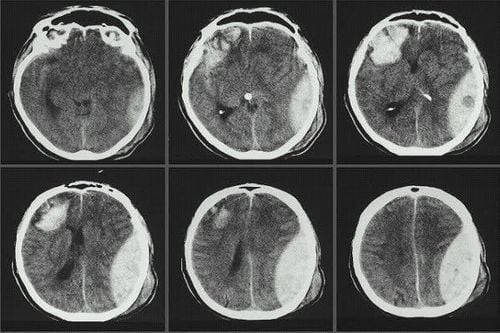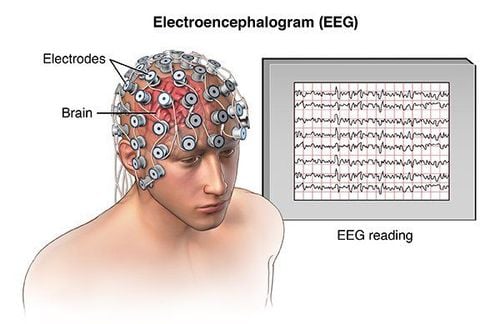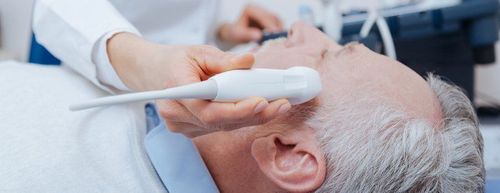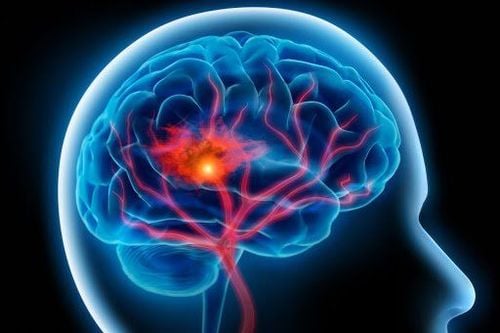This is an automatically translated article.
The article is advised by BSCK II Pham Thi Son - Neurologist - Department of Medical Examination & Internal Medicine, Vinmec General Hospital Hai Phong and Master, Doctor Bui Ngoc Phuong Hoa - General Internal Medicine Doctor - Department of Examination & Internal Medicine - Vinmec Danang International General Hospital.Headache is a syndrome caused by many different causes. Performing tests to help diagnose the exact cause of a headache will lead to more effective treatment.
1. Computed tomography of the brain
Computed tomography (CT) of the brain is a method of using X-rays to take pictures of the head and face. During the procedure, the patient will lie on a flat surface with the CT scanner attached and the head placed in the machine. This device will scan the X-ray through the head area. With each shooting angle, a small slice of the head and face will be produced. The supporting parts will tilt in many directions so that the machine is able to capture many different angles of the skull. All captured images will be saved on the computer and can also be washed out if necessary.The advantages of the cranial computed tomography method is the fast implementation time, the identification of the mass shock, the state of infarction, bleeding, hydrocephalus... Meanwhile, the disadvantages of CT skull scan brain is difficult to diagnose posterior fossa pathology. Patients with symptoms of cluster headache, tension headache, and functional headache almost all have normal images and support the diagnosis of headache quite well.

2. Cranial magnetic resonance imaging
Cranial magnetic resonance imaging (cranial MRI) is an advanced imaging technique, widely applied in the diagnosis of neurological diseases. This is also the most modern method capable of giving clear images to the pathological lesions in the brain region, can model the brain in many different dimensions, find out the exact cause of headache.The cranial magnetic resonance imaging method has advantages in diagnosing posterior fossa pathology, diagnosing software pathology (including brain, spinal cord, cervical soft tissue). However, the disadvantages of this method are: The scan time is quite long, one time taking about 30 minutes, which can cause problems if it has to be performed on many patients.
3. Brain magnetic resonance imaging
This is a magnetic resonance imaging procedure used to evaluate blood vessels inside and outside the brain, helping to diagnose cerebral vascular malformations, atherosclerosis, arterial occlusion, and detect cranial venous sinus thrombosis.4. Background erasing coding circuitry
Background erasure coding angiography is often indicated by doctors in cases where it is necessary to diagnose and intervene in diseases related to intracranial and extracranial blood vessels.5. Electroencephalogram to diagnose headache
EEG records the functional activities of the brain. EEG is especially valuable in the diagnosis and monitoring of status epilepticus. In particular, video EEG is a method to help monitor brain activity, the results are obtained in the form of video, recording all the activities of electrical brain waves for a long time, in order to identify abnormalities in the brain. Functional activity of the nervous system, from which it is possible to accurately diagnose the cause of epilepsy, and at the same time, it is possible to identify the type of epilepsy and the area of the brain where abnormal activity occurs.
6. Carotid ultrasound
Carotid ultrasound is the modality of choice for the classification, diagnosis, and examination of carotid atherosclerosis. This is one of the main causes leading to reduced blood flow to the brain and potential risk of cerebral embolism, the consequences manifesting in abnormal headaches.7. Transcranial ultrasound to find the cause of headache
In and evaluate the phenomenon of brain death... In which, one of the most important applications of the transcranial ultrasound procedure is the detection of cerebral arteriovenous malformations.8. Cerebrospinal fluid test
Doctors often order patients to do a cerebrospinal fluid test in case they need to diagnose the cause of headache accompanied by fever.In addition, depending on the case, the patient may have to do other laboratory tests, to look for non-brain headache causes, such as blood cell count, total blood count. urinalysis, liver and kidney function test, blood sugar measurement, blood fat test, electrocardiogram, echocardiogram...
Non-drug methods are often applied in the treatment of tension headaches:
Maintain a regular daily physical exercise regimen, such as walking, yoga, swimming. Avoid stressful situations, conflicts in work and life, arrange a reasonable time, have space for rest and activities. Keep the spirit always optimistic and happy, if you have a difficult problem, you should share it with relatives, friends and even a doctor to receive appropriate advice. Limit bad habits such as drinking alcohol, smoking, using stimulants, avoiding staying up late and building a diet full of nutrients. On the other hand, when a patient notices any symptoms of a headache, he or she needs to go to a reputable medical facility to perform appropriate diagnostic tests for headache and conduct proper treatment. self-medication. Because the right treatment of the disease, the right use of the drug will ensure the safety and effectiveness of treatment and reduce unnecessary costs for the patient.
Vinmec Hospital is one of the medical facilities trusted by many patients, helping to find the cause of headaches and provide the most appropriate treatment.
Please dial HOTLINE for more information or register for an appointment HERE. Download MyVinmec app to make appointments faster and to manage your bookings easily.














